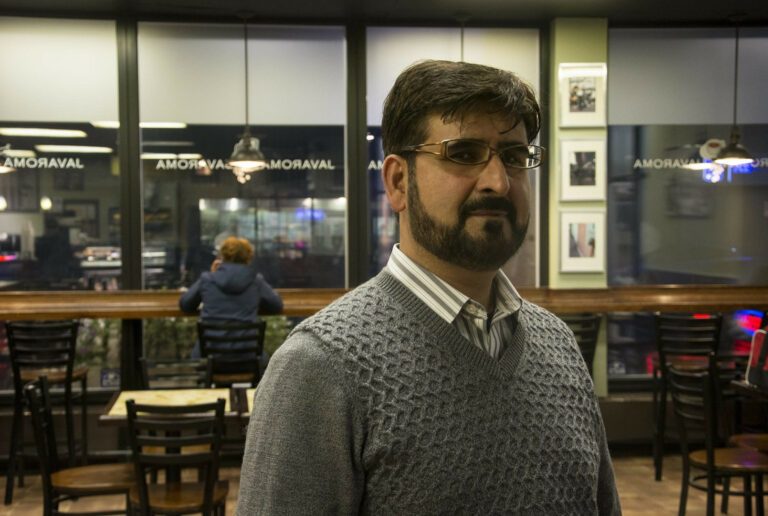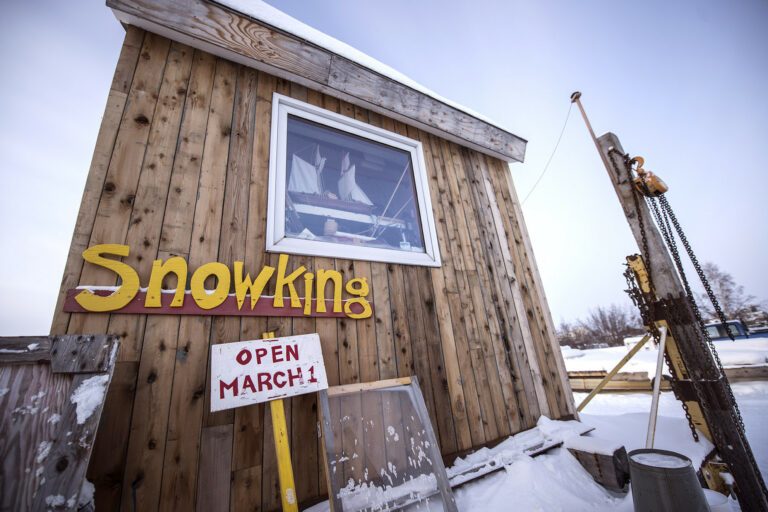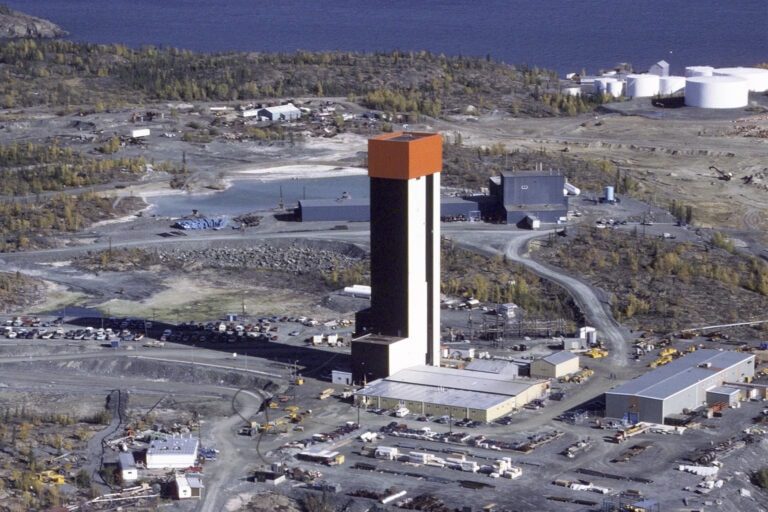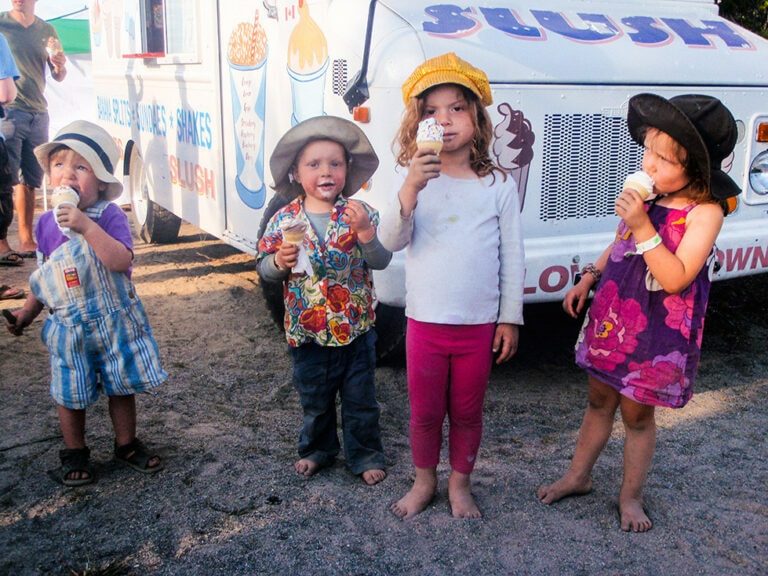The first shots rang out moments after the troops deboarded the plane — crack! crack! crack! from Lee-Enfield rifles in the frigid February air. A machine gun waited just beyond the edge of the tarmac. Floatplanes buzzed the air, swooping low across the Yellowknife Airport to drop their bombs. The disembarking Soviets — wrapped in white parkas, rifles strung over their shoulders, snowshoes at the ready — were picked off before they even had a chance to dig in.
It would be a long night before the first battalion of Canadian paratroopers, rushed north from Edmonton, descended on Back Bay with the mortars and machinery needed to retake the airport from the invaders. But in the meantime, the plucky Yellowknife Defence Force had won its first encounter. And won decisively.
Make no mistake — the parachutes dropped, the floatplanes pounced and Yellowknife’s little force of 110 half-trained soldiers helped stop the hypothetical invasion of North America.
Article continues below advertisement
No, this isn’t a scene from a alternate-history epic. It happened. Sort of. Pretty much. In February 1955, Yellowknife came under siege, figuratively speaking. And its own defence force, a medley of bushmen, miners, some reservists and handful of wild-eyed local pilots, won the day with striking success.
“Yellowknife Defence Force held the enemy in check and provided a firm base, a secure [drop zone] and considerable information on the enemy for the Assaulting Force [from Edmonton],” notes a recently declassified military document from 1955. “In addition, this local force reduced the strength of the enemy (estimated) by 50% by time MSF [Main Strike Force] arrived.”
Sure, the shots fired were blanks, and the bombs dropped were bags filled with lamp black. Yes, the ‘Soviets’ were actually soldiers from the Quebec-based Royal 22 Regiment, the Van Doos, and the only casualties were a broken foot and some frostbitten ears. But make no mistake — the parachutes dropped, the floatplanes pounced and Yellowknife’s little force of 108 half-trained soldiers helped stop the hypothetical invasion of North America.
The Van Doos unloading during Operation Bulldog III | Photo via Wikipedia
Operation Bulldog III
In the mid-1950s, Canada was on the frontline of the Cold War. Our much-feared Soviet neighbours across the polar cap possessed the Bomb, and they had the planes to carry them thousands of kilometres — not quite far enough to reach the continental U.S., but more than enough to touch down in some remote, undefended site to refuel before heading on to bomb New York or Chicago. In the fretful minds of Canadian and U.S. military strategists, that somewhere that looked a lot like Yellowknife, one of the only towns north of 60 with a runway large enough to land a Myasishchev M-4 bomber.
In the words of author Peter Pigott, writing in Far and Wide, the Complete History of Canada’s Sovereignty, the descent of the Iron Curtain meant that the North “was transformed from terra incognita to nuclear battlefield almost overnight, from sideshow to centre stage. The Canadian Arctic finally entered into the consciousness of those who lived below the 60th parallel — if only as a setting for the Dr. Strangelove scenario of that era.”
Lester Pearson, then Secretary of State for External Affairs, was worried enough about Soviet occupation that he questioned developing large-scale airport infrastructure in the North. A “scorched ice” policy would be best.
One vision even saw a Soviet invasion over the Arctic and down the Mackenzie Valley; as early as 1952, the Canadian Army had driven a force of specially designed snow vehicles — think old Bombardiers, but with serious armour — from Hudson Bay, across the Barren Lands to Inuvik, down the Mackenzie Valley and all the way to Edmonton. Lester Pearson, then Secretary of State for External Affairs, was worried enough about Soviet occupation that he questioned developing large-scale airport infrastructure in the North. A “scorched ice” policy would be best.
Against this backdrop came Operation Bulldog III, a massive military training operation dreamed up to test the Canadian Forces’ ability to fight in Arctic climates, and quickly deploy from the south to retake Northern centres captured by hostile forces. At the heart of the operation were the Edmonton-based Princess Patricia’s Light Infantry and supporting Air Force, who would form the “main strike force” of paratroops in the event of Northern invasion. But also in the mix was Yellowknife’s own gaggle of volunteers and irregulars, able to react immediately to an airborne invasion via the airport, harass the Soviets like so many deadly mosquitoes and help secure the surrounding area for the parachute drop.
Anderson-Thomson prepares
“It was like playing Cowboys and Indians all over again, with the added bonus that nobody was likely to get shot,” wrote John Anderson-Thomson, geologist, WWII veteran, justice of the peace, and a man whose name can be found on a Back Bay boulevard and a prominent local high-rise. He was in charge of the Yellowknife-based No. 7 Company Canadian Rangers at the time.
In the fall of 1953, word had come down to him that the “invasion” was planned for the following spring. He and his group of several dozen fellow surveyors, miners, pilots — “many of them, at least forty men who were really first class shots, any of whom was far above average regular army sniper ability” — got to work setting up Yellowknife’s defences.
Machine gun nests were dug into the snow on either side of the airport runway. “A perfect maze of snowshoe trails tracks” were run through surrounding forest, several of which, “if they followed they lead right into another strategically placed machine gun.”
“For further protection, we had fastened white cotton twine about knee high across the trails leading to our tents. If anyone walked into these strings, which could not be seen in the dark, the string pulled up a weight in the tent which alerted the two men on guard, who then knew exactly where the enemy were and could give them a blast of Sten gun fire,” wrote Anderson-Thomson. They even had “one senior-citizen ranger who had a very good watch dog, the dog would not bark but his hair would stand up on end and he would go to his master grumbling if a bear or a stranger was in the vicinity.”
All told there were 108 local defenders: 36 Rangers and 42 reservists and cadets who would take the battle to the airport, and 30 people in Headquarters, who would relay information about the invasion via NWT&Y Radio System down to Edmonton.
In the event their frontline was overrun, the defences Anderson-Thomson built had depth: three separate lines of tents, each “with spruce bough beds, airtight heater, gasoline lantern cut wood rations and kindling wood all ready to go, so that if we were beaten out of one position, all that we had to move were the sleeping bags and the rum.”
The attack
Anderson-Thomson had been told that Soviet planes were circling the polar cap several days leading up to the invasion, but their exact time of attack was unknown. It came mid-afternoon on Friday, Feb 25, a clear, crisp -40 day.
First, bursts of rifle fire from burrs of snow around the edge of the airport. Then the “Royal Yellowknife Airforce” — three bush planes manned by World War II pilots — began dive bombing.
“A local aircraft was used by the Canadian Rangers to drop home-made bombs (chimney soot in paper bags) on the enemy. This aircraft operated with more gallantry than would have been possible for long in real operations.”
Article continues below advertisement
“Led by squadron leader “Rowdy” Rutherford, they bored in in-line ahead and dropped their bombs, right in the middle of the Van Doos,” wrote Anderson-Thomson. “What a mess the poor devils were in, lamp-black all over them and on everything they touched!… A diabolical thing to do but all is fair in love and war, and we wanted to put some life in the exercise.”
“While live bombs and live bullets are the only real deciding factors, the umpires on both sides agreed that we had destroyed the invasion forces utterly and completely,” Anderson-Thomson added.
Writing his memoir 30 years on, Anderson-Thomson was surely remembering the victory through boast-tinted glasses. The military report makes no mention of dive-bombing Otters, and a 1955 Edmonton Journal article written by “General Staff Branch, HQ Western Command,” mentions one plane: “A local aircraft was used by the Canadian Rangers to drop home-made bombs (chimney soot in paper bags) on the enemy. This aircraft operated with more gallantry than would have been possible for long in real operations.”
Still, the YK force clearly was effective. After the mock-Soviets set up camp, they set out to try to take Yellowknife and the fuel stocks stored in large drums on Jolliffe Island. The Yellowknife Airforce had been grounded by the umpires to level the playing field, but the defence force still managed to stop the advance along Airport Road. In fact they were so effective in picking off enemy troops that the umpires had to bend the rules to let “casualties” keep on playing so as to provide “effective enemy strength for exercise purposes” when the actual army arrived the next day. This “became most unrealistic for the Local Defence Force… [and the] rapid re-instating of exercise casualties was disheartening to the locals,” the military report notes. “This force worked extremely well, and would, in actual fact, have made life very difficult for an enemy lodgement of this size.”
Nighttime was a flurry of minor skirmishes, though most of the “activity was confined to listening, patrolling, harassing by fire and reporting.”
After another failed enemy attempt to push through to Yellowknife the following morning, the first wave of paratroopers arrived from Edmonton. Photos attached to the military report show the sky dotted with dozens of parachutes drifting down onto the frozen lake. Once the main force arrived, Anderson-Thomson’s forces played a diminished role while the actual army called in a series of airstrikes and trekked, via snowmobile, sled, ski and snowshoe, towards the airport. The rest of the Edmonton force arrived the next morning, and by late afternoon the airport had been surrounded and recaptured.
And so ended the Battle for Yellowknife, a Boy’s Own-style dress-rehearsal for a potentially horrific event that thankfully never came to pass. The whole thing is summed up best by Anderson-Thomson, making a reference to one of WWII’s most famous David-and-Goliath tales:
“It all sounds like a bit of school-boy pranks, but you should remember that a few ski-equipped Finnish troops with the guts to fight for their homes and families, with nothing but their rifles, had up and completely demoralized a whole division of Russian troops which had finally to be withdrawn.”







